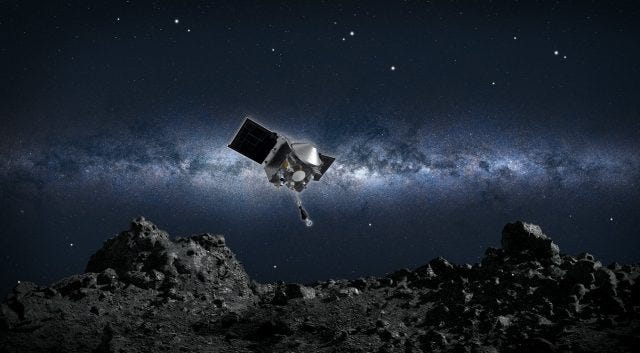NASA's OSIRIS-REx Successfully Collects Massive Asteroid Sample
Written on
Chapter 1: The Journey of OSIRIS-REx
NASA's OSIRIS-REx spacecraft has been orbiting the asteroid Bennu since late 2018. This extensive period allowed scientists enough time to meticulously identify an ideal landing site on the unexpectedly rugged terrain. It seems they made an excellent choice. Following a recent and successful touch-and-go operation, NASA announced that a substantial sample from Bennu has now been secured within the probe's sample return container.
Earlier this month, OSIRIS-REx descended to the surface, aiming for a light touch, which evolved into a deeper penetration than anticipated. NASA reported that the sampling arm may have penetrated approximately 19 inches (48 centimeters) of loose material before the nitrogen gas was released. This puff was intended to propel around 60 grams of material into the container, but it appears the mission achieved a significantly larger yield.
A brief, tense moment occurred when NASA confirmed that sizable pebbles had jammed the lid of the sample container. Consequently, asteroid fragments began to escape whenever the spacecraft moved. To prevent further loss, NASA decided to forgo the planned sample measurement over the weekend, as that would have risked losing even more material. Additionally, they abandoned any plans for a secondary sampling attempt at an alternate Bennu location and instead focused on securing the impressive collection they had already gathered.
The most recent images from OSIRIS-REx confirm that the sample is safely contained within the sample capsule. This module is destined for Earth's atmosphere, where a heat shield will protect it during reentry. While the exact quantity of material collected is still unknown, it is clear that the amount exceeds the minimum target of 60 grams. NASA estimates that OSIRIS-REx may have captured as much as one kilogram (2.2 pounds) of pristine asteroid soil. This is monumental—previous sample return missions have yielded materials measured in milligrams. For example, the recent Hayabusa2 mission aims to collect only 100 milligrams (0.1 grams) of asteroid regolith upon its landing in the coming months.

The successful return of such a significant amount of material from Bennu could represent a pivotal moment for scientific research. Most asteroid samples retrieved on Earth have been altered by atmospheric entry and often shattered upon impact. In contrast, Bennu has largely remained unchanged since the formation of the solar system, and the ample sample size will allow numerous research teams to conduct extensive tests, promising to provide invaluable insights into the early solar system.
As OSIRIS-REx and Bennu are currently millions of miles apart, the return journey will take some time. NASA plans to exit orbit in March 2021 when Bennu and Earth are optimally aligned for the return trip. The sample return capsule is expected to land on Earth in September 2023.
Now read: NASA to Sample Asteroid Said to Contain Building Blocks of Life | NASA’s OSIRIS-REx Spacecraft Successfully Boops Asteroid Bennu | NASA’s Asteroid Probe Spots Black Hole 30,000 Light-Years Away
Chapter 2: OSIRIS-REx Video Highlights
This official NASA broadcast provides a stunning 4K overview of the OSIRIS-REx asteroid sample return mission, showcasing the spacecraft's journey and its interactions with the asteroid Bennu.
This official NASA briefing offers an in-depth overview of the OSIRIS-REx asteroid sample return mission, detailing the objectives and significance of the operation.